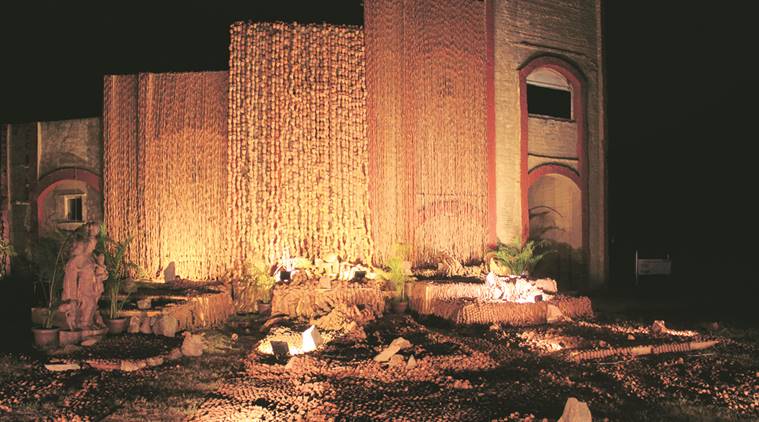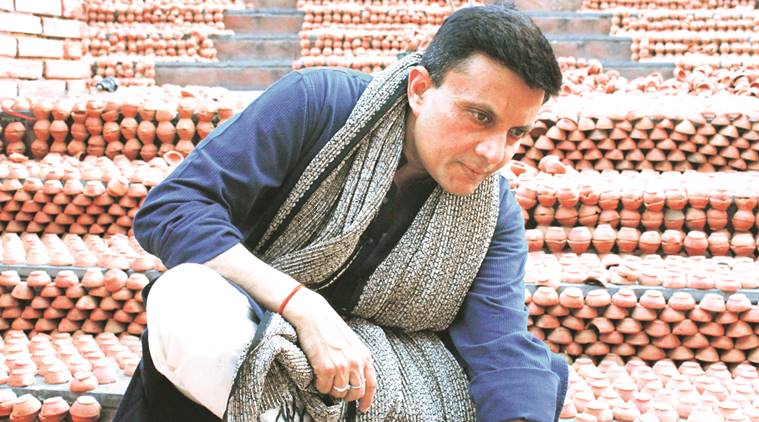From Sand to Dust
Manav Gupta weaves in stories of sustainability using quintessential byproducts of the Indian potter

Manav Gupta’s installations River Waterfront
The serenity of the riverbed is disturbed by the onslaught of water making its way into it, instantly bringing to the mind the gushing waters of various falls of the country — such as the Chitrakoot waterfalls or the Kempty Falls. But the fall in question is contemporary artist Manav Gupta’s installation, titled River Waterfront.
On display across the entire wall of Mati Ghar at Indira Gandhi National Centre for Arts (IGNCA), the mammoth artwork has been created with thousands of the earthen lamps (diyas) made by potters, local cigar (chillum) and earthen cups (kulhar). It pays an ode to the Ganga, glowing with yellow light at night, and symbolising how the river’s path flows from the mountains and pours into plains and distributaries. Five other tall installations come together to form Gupta’s public art project “Arth – Art for Earth”, serving as metaphors for environmental sustainability.
Delhi-based Gupta, who was the first artist-in-residence at the Rashtrapati Bhawan after being invited by APJ Abdul Kalam in 2003, brings out the nurturing qualities of the rain through another installation titled Rain. Chillums, recreating the effect of water droplets, hang from strings from the arjuna and neem trees (known for their medicinal properties) and give a drizzling effect to the garden spread across the 23-acre IGNCA premises. “What we do is peel off the barks and wound the trees for medicinal use. But the rains nurture the trees. The idea for this piece lay around why can’t we, as human beings, nurture the trees instead of taking away from them,” says Gupta.
Beehives, made using chillums and kulhars around the branches of trees, turn into storytellers in Bee-hive Garden, bringing attention to the dwindling population of bees. Gupta says, “The UN has declared the World Bee Day (May 20). Bees are a very important part of ecological system because they help in pollination and that’s how vegetables and crops grow. We are always the consumers. Bees are getting extinct and have been declared an endangered species. These beehives made in clay bring in the element of respecting other beings as well, besides nature.”
Then there is the artist’s own interpretation of Noah’s Ark, wherein a male figure appears holding the sail of a ship, made entirely of the three clay objects. “If we don’t take care of nature, we will need to run away from climate change, and row a boat to save ourselves,” he says.
On the use of over a lakh of diyas to create the river effect in River Waterfront and other artworks in his latest exhibition, Gupta says, “We have all grown up seeing the earthen lamp and it has been part of Indian ethos and spirituality. It has a very strange existence. That touched me. It lies on the roadside and is made by potters and we pick it and let it become the conduit of our prayers to god. Suddenly it becomes sacred. The entire perception changes from nothing to everything. In a minute after ceremonies, it is thrown back again after we have used it. That is the metaphor of the earthen lamp.”
In that sense, it is not surprising to see clay objects becoming Gupta’s tools lately, including the massive installation of the Ganga waterfront he created in 2016 at India Habitat Centre’s Plaza steps from his series ‘Excavations in Hymns of Clay’. The 50-year-old says, “The human existence and life is because of nature. We are panchmahabhuta — the five elements of earth, water, fire, air and ether. We are all dust to dust, and therefore I use clay. Clay and pottery are my mediums and I use nature as a laboratory.”
Gupta is among the few artists in the country who are using art to raise concerns around the environment. He says, “I try and address environmental problems without noise and the usual protest mode of high decibel shouting. But one can sensitise people. If it touches hearts and souls, art is a very powerful medium. Steve Jobs understood it and used it very well for Apple in terms of the way they present their design. Same can be said about the architecture of a city. My other aim is to engage with the masses, and take art out of the gallery and museum spaces.”
Arth, which translates to “meaning” in Hindi, was picked by the artist as the title of his project “to seek meaning and larger truths of life”. He adds, “Artha also means wealth in Hindi. So what’s the true wealth of humanity. It is actually nature and the natural resources. That is what makes us survive. It is not the money or commercialisation.”
The exhibition is on at IGNCA, CV Mess, Janpath, till October 22
For all the latest Lifestyle News, download Indian Express App






















 Artist Manav Gupta
Artist Manav Gupta Noah’s Ark
Noah’s Ark
No hay comentarios:
Publicar un comentario